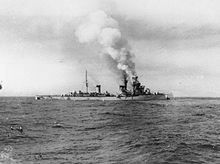HMS Ilex (D61)
|
HMS Ilex in Charleston in 1942
|
||||||||||||||||||||||
|
||||||||||||||||||||||
|
||||||||||||||||||||||
|
||||||||||||||||||||||
|
||||||||||||||||||||||
HMS Ilex (D61 / I61) was an eight-ship destroyer and a Leader I-class of the British Royal Navy in World War II . After damage from air raids off the Syrian coast in mid-June 1941 and the failure of repairs, the ship was subjected to emergency repairs and brought around Africa for repairs to the USA, where it was repaired from mid-March to September 1942. Used again in the Mediterranean, the Ilex was launched in December 1943 due to severe damage to the machinery and was never used again. It was broken up in Italy in 1948.
History of the ship
The Ilex was one of two ships that were ordered on October 30, 1935 from John Brown & Company in Clydebank . After her keel was laid in March 1936, the Ilex was launched on January 28, 1937 in Clydebank. She was put into service on August 7, 1937 as the last ship of the class, as the delivery of the main artillery had been delayed.
The destroyer was initially used together with the majority of its sister ships in the Mediterranean fleet in the 3rd destroyer flotilla.
War missions
After the war began, the flotilla was ordered back to the waters around the British Isles . During an interim escort mission, on October 12, 1939, together with the sister ship Imogen , the German submarine U 42 was sunk southwest of Ireland .
In April 1940, the ship was supposed to cover other destroyers that were supposed to lay mines in the coastal waters of Norway , which was still neutral at the time , as part of Operation Wilfred .
Already in mid-May the Ilex left Plymouth with the destroyers Hero , Hasty , Hereward and Havock in order to move again to the Mediterranean, where it was stationed in Alexandria . As part of a large-scale anti-submarine operation in the eastern Mediterranean, where almost all the ready-destroyer of the British Mediterranean Fleet were involved, it was possible the ship along with HMS Defender and HMS Dainty June 27, 1940, the Italian submarine Liuzzi to sink. Together with the latter destroyer , the Uebi Scebeli and Argonauta submarines were sunk two days later south-west of Crete, again supported by radio reconnaissance .
In July, HMS Ilex took part in the naval battle at Punta Stilo as escort for the battleships . Only a few days later the sea battle at Cape Spada followed , in which the Italian light cruiser Bartolomeo Colleoni was sunk on the way from Tripoli to Leros by a British association led by the light cruiser HMAS Sydney . The Italian cruiser, which continued to fire, but was no longer controllable after heavy hits by the Sydney , was sunk by torpedoes from the destroyers Hyperion and Ilex . The British destroyers ( Havock , Hyperion , Hasty , Hero and Ilex ) saved 525 men from the sunken Colleoni . The sister ship Giovanni dalle Bande Nere accompanying the Colleoni was able to escape to Benghazi .
In November, the destroyer was called to a Malta escort . After the end of the escort task, the covering fleet including HMS Ilex attacked the southern Italian naval base Taranto using torpedo bombers from the aircraft carrier HMS Ark Royal .
After another escort to Malta , the destroyer was involved in the Battle of Cape Matapan in March 1941 . In May 1941, the destroyer was called to another escort, which ran through the entire Mediterranean, to supply the beleaguered British 8th Army with military equipment. Uninterrupted operations followed at the end of May / beginning of June as part of the ultimately unsuccessful attempts to defend the island of Crete against German landing operations ( Operation Merkur ), and the subsequently necessary evacuation of the Allied troops.
In the following years the destroyer was also used in the eastern and central Mediterranean. During the occupation of the French mandate areas in the Middle East (Syria and Lebanon), the ship was attacked on June 15, 1941 by Junkers Ju 88 of II./LG 1 together with the sister ship Isis and both destroyers were badly damaged. After Haifa entrained Ilex could not be made ready for use again on site. Emergency repaired, the destroyer marched in many stages to the United States until March 1942, where the repair of the ship was carried out, which lasted until mid-1943.
The first use after the completion of the work took place on June 3, 1943 during a bombardment of the Italian island Pantelleria together with the Isis . As part of Operation Husky , the Allied landing on Sicily , the destroyer secured the landing areas. The Ilex sank together with the destroyer Echo the Italian submarine Nereide off Augusta . The ship was also used to land near Salerno ( Operation Avalanche ).
From December 1943, HMS Ilex was assigned to the reserve because of severe damage to the machinery. The repairs carried out in North Africa had low priority and were not completed by the end of the war.
Even after that, the ship stopped moving. It was scrapped in 1947 .
Individual evidence
- ^ A b Rohwer : Sea War 1939–1945. P.56.
- ^ Rohwer, p. 60.
- ↑ Rohwer, p. 62.
- ^ Rohwer, p. 113.
- ^ Rohwer, p. 127.
- ^ Rohwer, p. 132.
- ^ Rohwer, p. 361.
- ^ Rohwer, p. 373.
- ^ Rohwer, p. 383.
literature
- MJ Whitley: Destroyers of World War Two. Arms and Armor Press, London 1988, ISBN 0-85368-910-5 .

